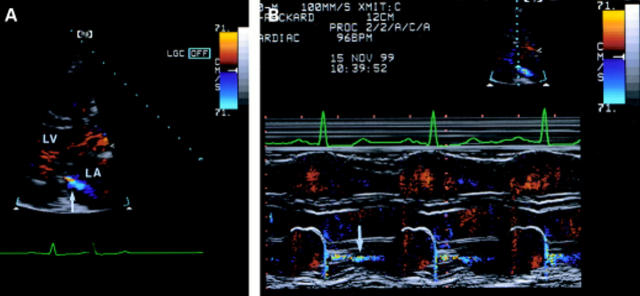Abstract
OBJECTIVE—To investigate the new onset of mitral regurgitation in patients with otherwise normal echocardiograms after anthracycline treatment and to assess its relation to other selected indicators of myocardial damage. DESIGN—Prospective echocardiographic and electrocardiographic study. SETTING—Tertiary paediatric cardiac referral centre. PATIENTS—305 patients, aged 2-33 years (median 14 years), treated with cumulative anthracycline doses of between 150-450 mg/m2 (median 180 mg/m2) for childhood malignancy. MAIN OUTCOME MEASURES—Colour flow Doppler detection of mitral regurgitation and its relation to changes in echocardiographic indices of left ventricular function (systolic and diastolic dimensions, fractional shortening) and to changes in the 12 lead ECG; and the prevalence of mitral regurgitation in the anthracycline treated patients in comparison with previously studied normal volunteers of similar age. RESULTS—34 patients (11.6%) developed ultrasound detectable mitral regurgitation, which was not apparent clinically, during or after anthracycline treatment, compared with only 1.8% of a normal population of similar age (p < 0.0001). Nine of the 34 also developed non-specific T wave abnormalities. All 34 patients had normal systolic function at the time of initial detection of mitral regurgitation, but four later developed impaired left ventricular function (5, 11, 20, and 27 months after the first detection of mitral regurgitation). CONCLUSIONS—Mitral regurgitation occurs much more often in patients treated with anthracyclines than in the normal population. Echocardiographic detection of new mitral regurgitation with or without ECG abnormalities may be an early predictor of anthracycline cardiomyopathy. Keywords: anthracyclines; mitral regurgitation; cardiomyopathy
Full Text
The Full Text of this article is available as a PDF (105.3 KB).
Figure 1 .
(A) Long axis parasternal echocardiogram showing a jet (arrowed) of trivial mitral regurgitation after anthracycline treatment. (B) Colour M mode recording showing the jet (arrowed) to be pansystolic.
Selected References
These references are in PubMed. This may not be the complete list of references from this article.
- Akasaka T., Yoshikawa J., Yoshida K., Okumachi F., Koizumi K., Shiratori K., Takao S., Shakudo M., Kato H. Age-related valvular regurgitation: a study by pulsed Doppler echocardiography. Circulation. 1987 Aug;76(2):262–265. doi: 10.1161/01.cir.76.2.262. [DOI] [PubMed] [Google Scholar]
- Bender K. S., Shematek J. P., Leventhal B. G., Kan J. S. QT interval prolongation associated with anthracycline cardiotoxicity. J Pediatr. 1984 Sep;105(3):442–444. doi: 10.1016/s0022-3476(84)80026-8. [DOI] [PubMed] [Google Scholar]
- Bristow M. R., Billingham M. E., Mason J. W., Daniels J. R. Clinical spectrum of anthracycline antibiotic cardiotoxicity. Cancer Treat Rep. 1978 Jun;62(6):873–879. [PubMed] [Google Scholar]
- Bu'Lock F. A., Mott M. G., Oakhill A., Martin R. P. Left ventricular diastolic function after anthracycline chemotherapy in childhood: relation with systolic function, symptoms, and pathophysiology. Br Heart J. 1995 Apr;73(4):340–350. doi: 10.1136/hrt.73.4.340. [DOI] [PMC free article] [PubMed] [Google Scholar]
- Druck M. N., Gulenchyn K. Y., Evans W. K., Gotlieb A., Srigley J. R., Bar-Shlomo B. Z., Feiglin D. H., McEwan P., Silver M. D., Millband L. Radionuclide angiography and endomyocardial biopsy in the assessment of doxorubicin cardiotoxicity. Cancer. 1984 Apr 15;53(8):1667–1674. doi: 10.1002/1097-0142(19840415)53:8<1667::aid-cncr2820530808>3.0.co;2-d. [DOI] [PubMed] [Google Scholar]
- Keizer H. G., Pinedo H. M., Schuurhuis G. J., Joenje H. Doxorubicin (adriamycin): a critical review of free radical-dependent mechanisms of cytotoxicity. Pharmacol Ther. 1990;47(2):219–231. doi: 10.1016/0163-7258(90)90088-j. [DOI] [PubMed] [Google Scholar]
- Larsen R. L., Jakacki R. I., Vetter V. L., Meadows A. T., Silber J. H., Barber G. Electrocardiographic changes and arrhythmias after cancer therapy in children and young adults. Am J Cardiol. 1992 Jul 1;70(1):73–77. doi: 10.1016/0002-9149(92)91393-i. [DOI] [PubMed] [Google Scholar]
- Schwartz C. L., Hobbie W. L., Truesdell S., Constine L. C., Clark E. B. Corrected QT interval prolongation in anthracycline-treated survivors of childhood cancer. J Clin Oncol. 1993 Oct;11(10):1906–1910. doi: 10.1200/JCO.1993.11.10.1906. [DOI] [PubMed] [Google Scholar]
- Thomson J. D., Allen J., Gibbs J. L. Left sided valvar regurgitation in normal children and adolescents. Heart. 2000 Feb;83(2):185–187. doi: 10.1136/heart.83.2.185. [DOI] [PMC free article] [PubMed] [Google Scholar]
- Von Hoff D. D., Layard M. W., Basa P., Davis H. L., Jr, Von Hoff A. L., Rozencweig M., Muggia F. M. Risk factors for doxorubicin-induced congestive heart failure. Ann Intern Med. 1979 Nov;91(5):710–717. doi: 10.7326/0003-4819-91-5-710. [DOI] [PubMed] [Google Scholar]
- Von Hoff D. D., Rozencweig M., Piccart M. The cardiotoxicity of anticancer agents. Semin Oncol. 1982 Mar;9(1):23–33. [PubMed] [Google Scholar]
- Weaver S. K., Fulkerson P. K., Lewis R. P., Leier C. V. A paucity of chronic electrocardiographic changes with adriamycin therapy. J Electrocardiol. 1978 Jul;11(3):233–238. doi: 10.1016/s0022-0736(78)80122-8. [DOI] [PubMed] [Google Scholar]



